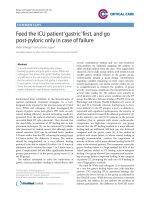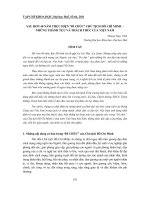Báo cáo " A study on urban development through land surface temperature by using remote sensing: in case of Ho Chi Minh City " potx
Bạn đang xem bản rút gọn của tài liệu. Xem và tải ngay bản đầy đủ của tài liệu tại đây (488 KB, 8 trang )
VNUJournalofScience,EarthSciences24(2008)160‐167
160
A study on urban development through land
surface temperature by using remote sensing:
in case of Ho Chi Minh City
Tran Thi Van
1,
*, Ha Duong Xuan Bao
2
1
InstituteforEnvironmentandResources,VietnamNationalUniversity,HoChiMinhCity
2
SaigonTechnologyUniversity
Received 20 November 2008; received in revised form 5 December 2008.
Abstract. In this research, remote sensing technology was used to evaluate urban development and
its thermal characteristics through mapping impervious surfaces and evaluating thermal infrared
images. The study is carried out in the northern part of Ho Chi Minh City, which is experienced an
accelerated urban development since the end of 1980s. Landsat and Aster images were used to
calculate the variation in urban impervious surfaces from 1989 to 2006. Thermal bands were
processed to obtain land surface temperatures for investigating the urban heat island effect
associated with increasing impervious surfaces both spatially and temporally.
Keywords: Emissivity; Impervious surface; Land surface temperature; Surface urban heat island;
Urban development.
1. Introduction
*
Urban development, as the major type of
human activities leading to land cover change,
has a great impact on the environment. In the
process of urbanization, natural vegetation
cover is largely replaced by impervious surfaces
such as buildings, roads, parking lots, sidewalks
and other built surfaces. Therefore, the
impervious surfaces are important as a key for
monitoring the urban development [1, 3, 9]. In
urban environment, where vegetation is fairly
sparse, build up or impervious surfaces are
stronger absorbers. The absorbed radiation is
gradually re-emitted as long-wave radiation that
_______
*
Corresponding author. Tel.: 84-8-38651132.
E-mail:
is responsible for warming up the boundary
layer of the atmosphere within the urban
canopy layer [8]. The temperature response and
reflective properties of impervious surfaces are
linked to the “urban heat island” (UHI) effect,
which often makes cities several degrees
warmer than the countryside. The hot climate of
cities affects human comfort and health because
of changes in sensible heat fluxes and the
concentration of atmospheric pollutants [2].
Therefore, urban development has a great impact
on the urban surface temperature. Urban areas
developed in spatial and industrial activity
context are considered as a factor contributed in
the global climate change.
Measuring the urban development and the
land surface temperature (LST) become
essential for several environmental applications
T.T.Van,H.D.X.Bao/VNUJournalofScience,EarthSciences24(2008)160‐167
161
and the planning, as well as management of
sustainable development in urban areas. There
are many efforts to map the impervious surfaces
and LST in urban environment, such as field
measurement, visual interpretation of aerial
photography. But they cost labor intensive, time
consuming and expensive task to manually
survey and map them. As a more cost-effective
alternative, the remote sensing technology has
been widely used in numerous applications in
order to obtain much of the earth surface spatial
information.
This paper has used remote sensing
technology to study in Ho Chi Minh City for
such objectives: (1) detecting the spatial urban
development through impervious surface (IS);
(2) deriving LST and analyzing its spatial and
temporal distribution in the relationship with
the urban IS and land cover; (3) examining the
surface urban heat island (SUHI) measured by
the urban-suburban LST differences. The time
period happens from 1989 to 2006.
2. Study area and data sets
2.1. Study area
Ho Chi Minh City is located in the South of
Vietnam and has a diversified landscape from
the northern to the southern part by the natural
elevation. The urban areas are mainly
concentrated in the central of the city. The
northern part is the agricultural land; the
southern one is low land with dense mangrove
forests. According to statistical data, the
population density has increased from 552
pers/km
2
in 1985 to 3,067 pers/km
2
in 2006 (in
urban areas about 10,905 pers/km
2
, in rural
areas about 648 pers/km
2
). The population
growth causes the spatial expansion being
through encroachment into adjacent agricultural
and rural regions, especially in the northern part
of the city due to the advantages of landscape
and relative high topography. Therefore, the
study area is limited to this part. Here is the
place where the urbanization process is happening
fairly strong in the recent years (Fig. 1).
Fig. 1. The study area.
2.2. Data sets
Landsat TM and Aster images were used as
the main data source in this research. Two
Landsat TM images have seven bands, included
six reflective bands in visible, near- and mid-
infrared spectral region with 30-m pixel size
and one thermal infrared band with 120-m pixel
size, acquired on Jan 16, 1989 and Jan 25,
1998. One Aster image acquired on 25 Dec,
2006 has 14 bands with different spatial
resolutions, i.e., three visible-near-infrared
(VNIR) bands with 15-m pixel size, six
shortwave infrared (SWIR) bands with 30-m
pixel size and five thermal infrared (TIR) bands
with 90-m pixel size. In the image processing
stage, all Aster and Landsat images were
converted from DN to radiance for further
suitable calculation. The 2006 Aster image was
then georeferenced in Universal Transverse
Mercator projection based on the topographical
map with RMS error less than 0.5 pixels. All
Aster bands were resampled in 15m. An image-
to-image registration was conducted between
the Aster image and the TM images in order to
keep registration errors to less than a pixel. The
15-m resampled interval was carried out for all
bands of the two TM images.
Thestudyarea
T.T.Van,H.D.X.Bao/VNUJournalofScience,EarthSciences24(2008)160‐167
162
3. Methodology
3.1. Measurement of the urban IS
The satellite sensors record the earth surface
from the radiance value which depends on the
land cover spectral characteristics. Urban areas
are heterogeneous and complex with different
kinds of the impervious construction materials,
which have different reflective and absorptive
capacity. So the IS will be one land cover
category for indicating the urban area in this
study. In digital interpretation, the confusion of
the bare land, moisture land and urban IS in the
satellite images usually happen. Therefore,
detecting and interpreting IS from satellite
images require the integrated techniques plus
the expert knowledge for the high accuracy. In
this study, the IS type will be retain as the main
category distinguished with other non-IS types
in the whole process of digital image. At first,
the supervised classification was used for
extracting 4 main types of land cover, including
IS, bare land, vegetation and water. There is no
unique classification method due to the data
acquired from multi sensors in a long time from
1989 to 2006. Through investigation in this
study, the Mahalanobis distance and Maximum
Likelihood Classifications were carried out in
dependence of the image characteristics and
statistics. Supervised classification method
shown that IS was excellently separated from
water and moisture land, but some bare land
was mixed into that one. The NDVI
(Normalized Difference Vegetation Index:
NDVI=(Red-NIR)/(Red+NIR)) image was then
used for making a threshold, where the NDVI
value less than “0” usually represents for urban
IS and water types. Classified IS and threshold
NDVI images were multiplied to remove the
mix pixels. The final IS results was accepted for
setting up the map of urban spatial distribution.
For change evaluation of IS, the study carried
out the post-classification comparison.
3.2. Measurement of LST in the study area
Satellite thermal infrared sensors measure
radiances at the top of the atmosphere, from
which brightness temperatures T
B
(also known
as blackbody temperatures) can be derived by
using Plank's law [7]:
()()
⎟
⎟
⎠
⎞
⎜
⎜
⎝
⎛
+
⎟
⎠
⎞
⎜
⎝
⎛
=
−
1/2ln
1
52
λ
λλ
Bhck
hc
T
B
, (1)
where h is Planck's constant (6.62×10
-34
J-sec),
c - velocity of light (2.998×10
8
m/sec), λ -
wavelength of emitted radiance (m), B
λ
–
blackbody radiance (Wm
-2
µm
-1
).
In order to determine the actual surface
temperature it is necessary to do atmospheric
correction and know the emissivity of the
surface land cover. Due to lack of atmospheric
measures during image acquisition, the
atmospheric correction was ignored. However,
these images were acquired in dry season in the
study area, so they appeared very clear. In this
context, the atmospheric effects on these
images were not significant. The emissivity (ε)
was calculated by using the formula of Valos
and Caselles [10]:
ε = ε
v
P
v
+ ε
s
(1 – P
v
), (2)
where ε
v
, ε
s
are the emissivities of the full
vegetation and bare soil, P
v
is the vegetation
cover fraction. They can be calculated by
NDVI. If land surface emissivity is known, the
LST (T
S
) can be calculated by using the Stefan
Boltzmann law [6]:
44
BS
TTB
σεσ
==
, (3)
therefore:
BS
TT
4
1
1
ε
=
, (4)
where σ is the Stefan Boltzmann constant
(5.67x10
-8
Wm
-2
K
-4
).
The Landsat TM images with one thermal
band 6 in the atmosphere window of 10.4-
12.5µm were used for deriving the LST. The
Aster images have 5 thermal bands from 10 to
14 in the window 8.125-11.25µm, but 2 bands
T.T.Van,H.D.X.Bao/VNUJournalofScience,EarthSciences24(2008)160‐167
163
13 and 14 with the same window as of Landsat
images will be used for calculating LST. The
choice is based on that approximately 80% of
the energy thermal sensors received in this
wavelength range are emitted by the land
surface [4] and the maximum value of LST is
usually obtained in this range [5]. The results
gave the spatial distribution of LST in the
whole study area. Then the SUHI was evaluated
based on this LST distribution between urban
and rural areas.
Besides that, historical climate information
such as the data of annual mean air temperature
from 1989 to 2006 are collected from the
Southern Region Hydrometeorological Center.
These in-situ data were recorded in only one
observation meteorological station named Tan
Son Hoa. They were used for evaluating the
trend of the temperature in urban area.
4. Results and discussion
4.1. Urban development through IS
The results of image derived IS were
obtained with a fairly high accuracy through
confusion matrix. The overall accuracy and
Kappa coefficient of all 3 years were greater
than 96%. By history, the urbanization in the
northern part of Ho Chi Minh City was rapidly
developed after formation of the five new
districts (districts 7, 9, 2, 12, and Thu Duc) in
1997. The IS map (Fig. 2) and results (Table 1)
in 1998 year indicated that the development of
IS area is approximately 2.5 times bigger than
that in 1989. The IS area from 1989 to 2006
was extended in about 6.5 times. Investigation
of the IS in 3 years (1989, 1998 and 2006) shows
that the IS was concentrated and expanded from
the central part of the city with a growing
tendency to the North, West and East of the city
and along the main roads. Fig. 3 shows the
trend of urban IS development with a strong
slope between 1998 and 2006, indicating that
Ho Chi Minh City is becoming a mega city in
the late years. It requires a reasonable urban
management for sustainable development in the
future.
Table 1. Total area of impervious surfaces in 1989,
1998, and 2006
Year IS area (ha)
% total area
2006 46,488.38
31.98
1998 18,693.32
12.86
1989 7,147.42
4.92
1989
1998
2006
Fig. 2. IS distribution of Ho Chi Minh City in 3 years.
T.T.Van,H.D.X.Bao/VNUJournalofScience,EarthSciences24(2008)160‐167
164
0
5000
10000
15000
20000
25000
30000
35000
40000
45000
50000
1989 1998 2006
Year
Area (ha)
Fig. 3. The trend of urban IS development in Ho Chi
Minh City.
4.2. LST distribution and impact of the urban
development on surface temperature
The LST measurements from the
meteorological stations are recorded only in
very sparse sites. Therefore, they can not tell us
the temperature in somewhere we need.
However, the remote sensing method can do it.
The retrieved LST maps show the picture of
LST distribution in an area. In this study, the
accuracy of the satellite LST retrieval is
determined by comparing the estimated LST
from Aster image 2006 to the in-situ
measurements in 10 observed points. It showed
that the bias was less than 2
o
C. The maps in
Fig. 4 were produced to show the spatial
distribution of emissivity-corrected LST in
1989, 1998 and 2006. The statistics of LST in
Table 2 indicates that the highest temperature
was increased from 39.8
o
C in 1989 to 49.4
o
C in
2006. It was only the instantaneous results in
the time of image acquisition. But if it is
considered that the 2006 image was recorded in
the late of cool period of December, it could be
think that the temperature was increased by time.
The remote sensing method provides not
only a measure of the magnitude of surface
temperatures of the entire city area, but also the
spatial extent of SUHI effects. From Fig. 2 and
4 it is obvious that the IS distribution is
proportional to the high LST one. The LST
maps in 1989 and 2006 show the extension of
the high LST areas with the expansion of
developed urban areas. The heat islands were
found in some hot spots over the study area. In
the 1989 map, the high LST is shown in the
bare land in the north of the city. There was not
to be an extensive hot spot in the old urban
areas. In this time the urban IS was not much in
comparing to vegetation cover, so it was less
effective to increase the LST.
The rapid process of urbanization after
formation of the five new districts in 1997
caused the increase of the SUHI from 1998 to
2006. In the 2006 LST map, an extensive SUHI
is concentrated in the central part city. One
SUHI was developed in the north of the city in
Cu Chi District. The third one was found in Thu
Duc District of the eastern part. The highest
LSTs (>45
o
C) were found in the industrial
zones, where the temperature was created from
the production activities plus the received solar
radiance. The urban areas have suffered the
temperature within 36-40
o
C. In addition, the
wind circulation in urban areas is limited by the
building elevation and structure. So with this
temperature level human body always senses
uncomfortable and requires air cooling. The
more air conditions are used, the more heat is
released, and the temperature is increased then.
In spite of that, in the suburban and rural areas
where the agricultural land still remains with
the full vegetation cover the LST usually is
lower.
Table 2. Statistics of LST at the time of satellite
image acquisition
Year Min Max
1989-01-16 12.1 39.8
1998-01-25 22.3 43.5
2006-12-25 17.5 49.4
T.T.Van,H.D.X.Bao/VNUJournalofScience,EarthSciences24(2008)160‐167
165
1989
1998
2006
Fig. 4. Distribution of land surface temperature in 1989, 1998 and 2006.
4.3. The relationship between LST and land
cover types
The relationship between LST and land
cover types was investigated for further
understanding the effect of urban development.
Table 3 and Fig. 5 show the average
temperature of land cover. It is apparent that
where the human is present, the heat is released
and increased. The highest temperatures are
always in industrial zones and urban areas. This
implies that urban growth brings up surface
temperature by replacing natural vegetation
with non-evaporating, non-transpirating
surfaces such as impermeable stone, metal and
concrete. The agricultural land with grown
crops in suburban areas has the lower
temperature. Forest shows a considerable low
surface temperature in 3 years, because dense
vegetation can reduce the amount of heat stored
in soil and surface structures through
transpiration. By time with the same type of
land cover their LST show a positive slope (Fig.
6). It tells us that the temperature tendency is
increased, particularly when the process of
industrialization and urbanization are developed
by human demands. The graph in Fig. 7
exhibits the trend of in-situ air temperature
measurement in meteorological station located
in urban area of Ho Chi Minh City. The air
temperature is the result of the process of
atmosphere heat from the sun radiation and
from the earth surface. So the high LST will
contribute in high increase of the air
temperature. This graph reflects the same
picture from the remote sensing results.
Table 3. Average land surface temperature (
o
C) by land cover type
1/16/1989 1/25/1998 12/25/2006
Land cover type
Min Max Mean Min Max Mean Min Max Mean
Industrial zone - - - 40.0 43.5 41.7 45.0 49.4 47.2
Built-up land 33.7 36.3 35.0 34.5 39.3 36.9 35.0 43.9 39.4
Bare land (construction site) 32.6 36.7 34.6 33.7 38.8 36.2 31.9 41.4 36.6
Land after crop 31.6 33.1 32.3 33.4 37.7 35.6 33.9 41.9 37.9
Land under crop 27.7 32.2 29.9 25.6 30.8 28.2 28.3 34.2 31.2
Forest 23.1 27.1 25.1 24.7 28.4 26.5 28.4 29.7 29.1
Water 20.3 24.9 22.6 23.9 29.8 26.9 26.8 33.5 30.1
T.T.Van,H.D.X.Bao/VNUJournalofScience,EarthSciences24(2008)160‐167
166
20.0
25.0
30.0
35.0
40.0
45.0
50.0
Industrial
zone
urban bare land land after
crop
land under
crop
for est w ater
Land cover
Land surface temperature (ToC)
1/16/1989 1/25/1998 12/25/2006
Fig. 5. Average LST by land cover in 1989, 1998,
and 2006.
20.0
25.0
30.0
35.0
40.0
45.0
50.0
1989 1998 2006
Year
Surface temperature (oC)
Industrial zone
urban
bare land
land after crop
land under crop
forest
water
Fig. 6. The trend of average LST by land cover in
1989, 1998, and 2006.
26.0
26.5
27.0
27.5
28.0
28.5
29.0
1989 1991 1993 1995 1997 1999 2001 2003 2005
Year
Annual average air temperature (oC)
Fig. 7. Annual mean air temperature in the urban
area of Ho Chi Minh City, 1985-2006.
4.4. Urban environment management with
reasonable control of imperviousness and heat
island effects
Urban areas are already remarkable
concentrations of climate vulnerability and
projected rates of urban development mean that
vulnerability will increase at the same time as
the impacts of climate change become
increasingly manifest. Actions by planners,
designers and infrastructure owners in
sustainable management of urban environment
are required in the short term if cities are to
avoid becoming ever more vulnerable in the
long term. These are already urgent problems.
Heat islands can amplify extreme hot
weather events, which can cause heat stroke and
lead to physiological disruption, organ damage,
and even death - especially in vulnerable
populations such as the elderly. Summer-time
heat islands increase energy demand for air
conditioning, raising power plant emissions of
harmful pollutants. Higher temperatures also
accelerate the chemical reaction that produces
ground-level ozone, or smog. This threatens
public health and the environment.
The above investigation shows that urban
development relates to the impervious surface
presence and affects on SUHI extension which
can be detected from the satellite images.
Therefore, in the urban management strategies
it is necessary to control the urban development
according to the plan. Moreover, vegetation
plays an important role in making the urban
climate equable. According to the information
from the website of Ministry of Natural
Resources and Environment in 2008, the green
space in Ho Chi Minh City achieves on an
average only 0.6m
2
/person, which is 10 times
lower than the standards. Hence, there are some
steps that the community can take to lessen the
impacts of heat islands, such as (1) installing
cool roofs or vegetated green roofs, (2)
installing green roofs, (3) switching to cool
paving materials and (4) planting trees and
vegetation.
T.T.Van,H.D.X.Bao/VNUJournalofScience,EarthSciences24(2008)160‐167
167
However, some factors, such as land-use
patterns, materials used in road and building
construction, and the coverage of urban trees
and vegetation, can be directly affected by the
decision makers. This is where policies and
programs for reducing the impacts of heat
islands (and achieving related environmental
and energy-savings goals) can be most
effective.
5. Conclusions
Urban development intensity and spatial
extent can be characterized by using satellite
remote sensing data through mapping the
impervious surface distribution. This study has
shown that different urban development
intensities, defined by IS, have significant
effects on LST. The urban and built-up area in
the northern part of Ho Chi Minh City has
expanded by 6.5 times from 1989 to 2006 year,
and the urban development has altered the
magnitude and pattern of SUHI. Application of
satellite thermal infrared data to the study of
LST suggests that different land cover types
have distinctive responses. The conversion of
natural and vegetated surfaces into urban
development purposes will rise the temperature
and increase the spatial variability of LST.
Temperature is an important meteorological
factor in the process of forming the climate.
The urban development and expansion lead to
increase of LST and formation of extensive
SUHI over the urban areas. This has impact not
only on the local level but also on the global
level if the temperature is increased more and
more. If LST can be used as a surrogate for air
temperature, then urban planners and managers
can utilize satellite-derived measurements to
indicate the need for new or revised urban
design and landscaping policies for mitigating
the UHI and SUHI effects on the climate
condition.
Acknowledgements
This paper was completed within the
framework of Fundamental Research Project
719706 funded by Vietnam Ministry of Science
and Technology.
References
[1] C.L. Arnold, C.J. Gibbons, Impervious surface:
The emergence of a key urban environmental
indicator, American Planning Association
Journal 62, 2 (1996) 243.
[2] K.B. Barnes, J.M. Morgan III, M.C. Roberge,
Impervious surfaces and the quality of natural
and built environments, Project to map
impervious cover for the entire Chesapeake Bay
and Maryland Coastal Bays watersheds,
/>ous/indicator.asp, 2001.
[3] G. Bowles, Impervious surface - an environmental
indicator, The Land Use Tracker 2, 1 (2002).
Available at
landcenter/tracker/summer2002/envirindic.html
[4] K.P. Czajkowski et al., Estimating environmental
variables using thermal remote sensing, in
Thermal Remote Sensing in Land Surface
Processes, CRC Press, New York, 2004.
[5] A.N. French, T.J. Schmugge, J.C. Ritchie, A.
Hsu, F. Jacob, K. Ogawa, Detecting land cover
change at the Jornada Experimental Range, New
Mexico with ASTER emissivities, Remote
Sensing of Environment 112 (2008) 1730.
[6] R.P. Gupta, Remote sensing geology, Springer-
Verlag Berlin Heidelberg, Germany, 1991.
[7] B.L. Markham, J.L. Barkewr, Landsat MSS and TM
post calibration dynamic ranges, exoatmospheric
reflectance and at-satellite temperatures, EOSAT
Landsat Technical Notes 1 (1986) 3.
[8] T. Oke, Boundary layer climates, Routledge,
New York, 1987.
[9] T.R. Schueler, The importance of imperviousness.
Watershed Protection Techniques 1, 3 (1994) 100.
[10] E. Valor, V. Caselles, Mapping land surface
emissivity from NDVI: application to European,
African, and South American areas, Remote
Sensing of Environment 57 (1996) 167.
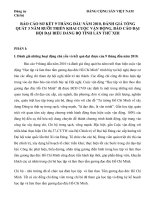
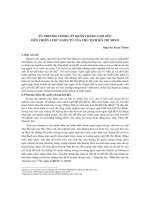
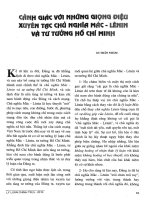


![[ Báo cáo khoa học ] Tối ưu hoá mạng quan trắc động thái nước dưới đất vùng thành phố hồ CHí minh](https://media.store123doc.com/images/document/14/ri/eh/medium_ehf1398177039.jpg)


